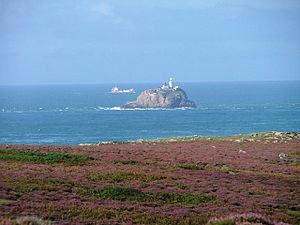Bishops and Clerks facts for kids
The Bishops and Clerks are a group of rocks and small islets. They are found about 1.5 miles (2.4 km) west of Ramsey Island in Pembrokeshire, Wales.
Contents
Why the Name "Bishops and Clerks"?
There are a couple of ideas about how these islands got their interesting name.
One old story says the name came from a shipwreck in the 1500s. The story goes that only three people survived: Miles Bishop, James Clerk, and Henry Clerk. However, most people today think this story is probably not true.
A more likely idea is that the name comes from how the islands look. There's a larger island, like a "Bishop," surrounded by smaller islands, like "clerks" (assistants). You can find similar names for groups of islands in other places, like the Isles of Scilly and the Bishop and Clerk Islets far away in the Pacific Ocean.
These islands were called "the Bisshoppis and his clerkis" in old sailing guides from the 1400s. A map of Pembrokeshire from 1578 also called them "The bisshop and his clarkes."
A historian named George Owen of Henllys wrote in 1594 that the "Bishop and his clerks" were seven islands near Ramsey Island. He also mentioned that these islands "preach deadly doctrine" in winter, meaning they are very dangerous for ships when the weather is bad.
Island Geography
The Bishops and Clerks are made up of four main groups of islets. Here they are, starting from the north:
- North Bishop (44 metres, 144 feet tall)
- Carreg Rhoson (44 metres, 144 feet tall)
- Maen Rhoson
- Daufraich
- Maen Daufraich
- Moelyn
- Cribog
- Emsger or South Bishop (37 metres, 121 feet tall)
There are also three smaller rocks called Carreg-trai, Llechau-isaf, and Llechau-uchaf. These rocks are often covered by waves and are located between the Bishops and Clerks and Ramsey Island.
The South Bishop Lighthouse

The islands and the rocks around them are very dangerous for ships. Many shipwrecks have happened in these waters, especially near North Bishop. Because of this danger, the South Bishop Lighthouse was built on Emsger (South Bishop) in 1939 to help guide ships safely.
Island Rocks
The rocks that make up the Bishops and Clerks islands are very old.
The two northern groups of islets are made of a tough rock called gabbro. This rock is formed when hot, melted rock (magma) cools down slowly underground.
The Daufraich group of islands to the south are made of a similar rock called microtonalite. This is also an igneous rock, meaning it formed from cooled magma.
The most southerly island, Emsger, is made of rhyolite. This rock also comes from cooled magma, but it cools faster, often from volcanic eruptions.
All these rocks formed a very long time ago, during the early Palaeozoic Era. Some other rocks nearby, like Llechau-uchaf, are made of 'Lingula Flags' from the late Cambrian period. Carreg-trai is made from Ordovician volcanic ash called tuffs.
The seabed between these island groups is mostly made of sandstones and mudstones from the Cambrian and Ordovician periods. However, sand and gravel partly cover these rocks.

